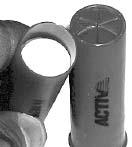Three steps to perfect crimps: |
||
|
|
|
Overshot Card Wad |
Undershot Filler Wads |
Overpowder Wad (Gas Seal) |
| Your final crimp
determines the quality of your load. Overly deep crimp centers alter the load pressure and may ruin the shotcup by reaching over the petals and "hooking" the wad. When the load is fired, the wad has no choice but to push its way out. If hooked under the outer edge of a crimp, the hull may actually come apart, ruining the pattern, of course, and leaving the shooter wondering why only 1/2 of a shell remains. On the other hand, crimps that are not deep enough do not have rigidity necessary to contain the pellets and contribute to sudden pressure loss during the firing cycle, a common cause of misfires, also known as "blooper loads." Crimps are to be pushed open from the center, which happens when the pellets are matched to the top of the shotcup and an overshot card is in place. A good crimp is the outcome of many small adjustments, both inside the shell and at the crimping station of a reloading press. Shell and press adjustments must be considered for all your different loads, as even a change of shot size will alter your load height, requiring you to use filler wads of different thickness. Three types of wads are used to find proper load height in shotshells. The over powder gas seal or nitro wads _ placed directly on top of the powder charge and below the shotcup; the filler wad placed either on top of the gas seal or inside the shotcup and finally, the overshot card wad. Each is an intrinsic part of high-performance loads. |
||
| Overshot Card Wads - Platform for crimp contact | ||
| The overshot card wad is set on top of the shot payload just before crimping the shell closed. Select an overshot card that is the same gauge as your loads. For instance, if you are loading 12 gauge, use a 12 gauge overshot card. You can use any type of BPI overshot card in any load. The thicker overshot cards, such as the Clear Overshot Card Wads, offer a stable platform for roll crimps, slugs and buckshot _ situations where you may not have a flat crimping surface on top of the pellets and the extra stability of the overshot is helpful. The .030" overshot and the Tyvek Discs are used in your more typical loads. Overshot cards improve shotshell performance by giving the crimp a flat, uniform platform on which to rest. Furthermore, as demonstrated in the ballistic laboratory, load pressures become stabilized allowing for more predictable and increased load performance. | ||
| Filler Wads - Felt, Cork and Fiber: Adjusts shot payload height inside shotcup | ||
| Magnum-velocity
loads focus punishment upon the base of the shotcup. Placing a filler wad underneath the
shot insulates the pellets from direct contact - as well as giving the shooter some relief
from felt recoil, by absorbing energy. Filler wads furthermore serve the purpose their
name implies: They take up space within the loads. Quality filler wads have several requirements: They must be very light, they need to be strong enough to support the payload directly without disintegrating under stress of setback. Filler wads must flex, just enough to keep the crimp under a slight tension and also absorb minor variables in payload height. High performance shotshells are usually designed to make room for filler wads, taking advantage of these benefits. The filler wads listed in the BPI Catalog all meet these performance criteria. The height of pellets inside the shotcup is properly adjusted when the top layer of pellets is even with, or just slightly above the top of the shotcup. When filler wads are placed inside a shotcup, the reloader chooses a smaller gauge to accommodate the smaller diameter inside. For instance, if you are loading 10 gauge plastic shotcups, use 12 gauge fillers inside. If you are using 12 or 16 gauge plastic shotcups, place 20 gauge filler inside the shotcup. 20 gauge shotcups holds 28 gauge fillers very nicely. By design, filler wads - felt, cork or fiber - can be added or removed from any load as necessary. |
||
| Overpowder seals - The interface between powder and load | ||
| Overpowder seals
are a direct connection between your shot payload and the burning powder that pushes it.
These seals need to be tough, to manage heat, and offer a consistent containment seal
between the hull, then later the forcing cone to the barrel to the choke. A failure of the
gas seal is a failure of a load - any sudden drop of pressure will compromise the powder
burn cycle as well as existing energy. Overpowder wads boost the overall height of a load. Some hulls have very deep basewads. If you see that a shotcup is sitting too low inside of the hull it can be boosted to proper height (about 1/4" from the top) by adding an appropriately-sized nitro card below the plastic gas seal. Some loads use a series of waxed nitro cards and filler wads as the entire wad column. This is done to reduce litter. Once fired and exposed to weather, the fiber wads disintegrate very quickly. BPI is testing and producing modern load recipes using current powders and pellets with this new/old design. We are making friends among landowners too. Plastic Gas seals, are used in certain load recipes to enhance load performance beyond the range of ordinary components. Some loads will even utilize double gas seals _ offering superb sealing qualities in demanding conditions produced by high-velocity magnum loads. As velocity and payload move into magnum territory, demands placed on component increase. To get a load to perform at full potential, consistently, specialized wad combinations become part of the recipe. |
||


